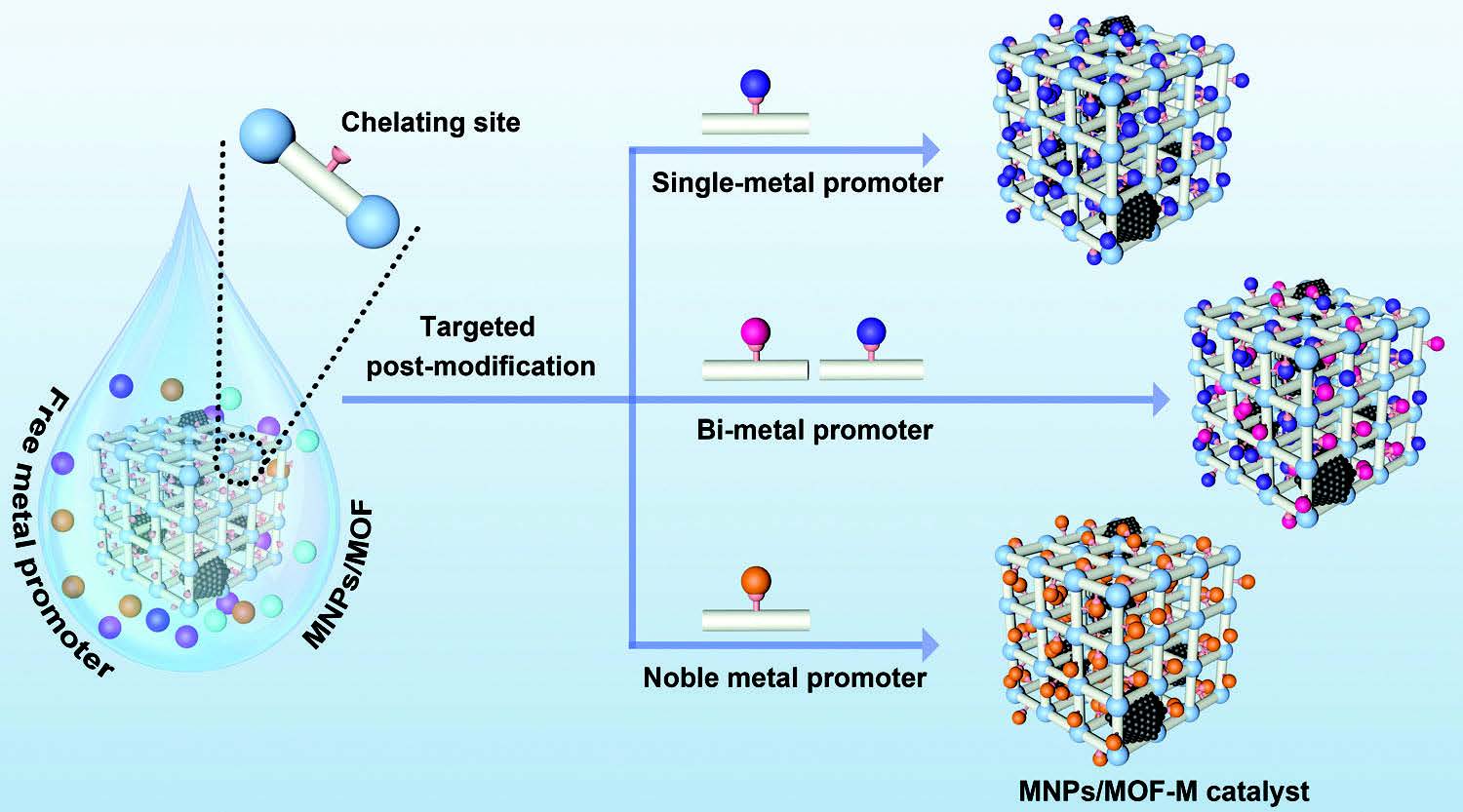| Jul 27, 2023 | |
Unleashing the power of metal-organic frameworks for next-gen catalysts |
|
| (Nanowerk Spotlight) For nearly a century, metal promoters have been recognized for their significant role in catalysis. These substances, often metal salts, have the ability to regulate the catalytic activity of metal catalysts in reduction reactions. Despite their importance, understanding the precise action mechanism behind metal promoters has remained a challenge due to their complex existing status. This challenge has been a major roadblock in the advancement of catalysis, a field that plays a crucial role in various industries, from energy production to manufacturing. | |
| In a groundbreaking study, a team of researchers from the Key Laboratory of Flexible Electronics (KLOFE), Institute of Advanced Materials (IAM) at Nanjing Tech University, and other institutions, have discovered a new function for Metal-Organic Frameworks (MOFs) that could revolutionize the field of catalysis. | |
| The research, published in Advanced Materials ("New Function of Metal–Organic Framework: Structurally Ordered Metal Promoter"), demonstrates how MOFs can be used to construct structurally ordered metal promoters, enhancing the selectivity of catalysts in chemical reactions. | |
 |
|
| Schematic process of incorporating metal promoters onto MOF-supported catalysts via a flexible targeted post-modification strategy. First, MOFs with uniform chelating sites are designed as ideal carriers to support catalytically active metal NPs; second, more than ten kinds of metal promoters, including non-noble and noble metal promoters, are selectively fixed onto these chelating sites of MOF carriers, either singly or simultaneously, through the specific coordination between metal promoters and chelating sites (targeted post-modification strategy). (Reprinted with permission by Wiley-VCH Verlag) | |
| The researchers have now developed a new function for MOFs as an ideal model to construct structurally ordered metal promoters using a targeted post-modification strategy. MOFs, with their ordered periodic networks and high porosity, are considered potential candidates for building structurally ordered metal promoter models. This unique characteristic of MOFs opens up a new avenue in the field of catalysis, providing a platform for the development of more efficient and selective catalysts. | |
| The team's strategy involved incorporating free metal promoters into the chelating sites of MOF-supported catalysts. This provided a feasible research platform to elucidate the action mechanism behind the metal promoters in the catalytic field. This innovative approach is a significant step forward in the field of catalysis, as it allows for a deeper understanding of the role and function of metal promoters, which could lead to the development of more efficient and effective catalysts. | |
| The researchers used a type of Zr-based MOF (bpy-UiO) as a carrier to incorporate Pd nanoparticles and to chelate metal promoters. The Pd nanoparticles were selected as catalytically active sites due to their high activity and selectivity in nitrostyrene hydrogenation. This process of incorporating Pd nanoparticles into the MOF structure is a testament to the versatility and potential of MOFs in the field of catalysis. | |
| The team then introduced Cu promoters into the Pd/bpy-UiO to synthesize a Pd/bpy-UiO-Cu catalyst using a targeted post-modification strategy. The resulting catalyst showed high selectivity towards 4-nitrophenylethane in 4-nitrostyrene hydrogenation. This was mainly due to the enhanced interaction between Pd nanoparticles and MOF carriers induced by Cu promoters, which inhibited the hydrogenation of 4-nitrophenylethane. | |
| This innovative approach opens up a new route to synthesize efficient catalysts with structurally ordered metal promoters. It also provides a new tool for the design and synthesis of high-efficiency catalysts and offers an effective platform for elucidating the structure and mechanism behind promoters in the catalytic process. | |
| The scientists believe that their findings could have significant implications for the field of catalysis, potentially leading to more efficient and selective catalysts in the future. The use of MOFs to construct structurally ordered metal promoters could revolutionize the way we understand and utilize catalysts, opening up new possibilities in various industries. | |
| The potential applications of this research are vast. In the energy sector, for instance, more efficient and selective catalysts could lead to more sustainable and cost-effective production methods. In the manufacturing industry, these advancements could lead to the development of new materials and processes, driving innovation and economic growth. | |
| Furthermore, this research could have implications beyond these industries. In the field of environmental science, for instance, more efficient catalysts could be used to develop more effective methods for pollution control and waste management. In the pharmaceutical industry, these catalysts could be used to develop new drugs and treatments. | |
| In conclusion, this groundbreaking research represents a significant advancement in the field of catalysis. By harnessing the unique properties of MOFs, they have opened up new possibilities for the development of more efficient and selective catalysts. This could have far-reaching implications, potentially revolutionizing a range of industries and paving the way for future innovations in the field. | |
 By
Michael
Berger
– Michael is author of three books by the Royal Society of Chemistry:
Nano-Society: Pushing the Boundaries of Technology,
Nanotechnology: The Future is Tiny, and
Nanoengineering: The Skills and Tools Making Technology Invisible
Copyright ©
Nanowerk LLC
By
Michael
Berger
– Michael is author of three books by the Royal Society of Chemistry:
Nano-Society: Pushing the Boundaries of Technology,
Nanotechnology: The Future is Tiny, and
Nanoengineering: The Skills and Tools Making Technology Invisible
Copyright ©
Nanowerk LLC
|
|
|
Become a Spotlight guest author! Join our large and growing group of guest contributors. Have you just published a scientific paper or have other exciting developments to share with the nanotechnology community? Here is how to publish on nanowerk.com. |
|
